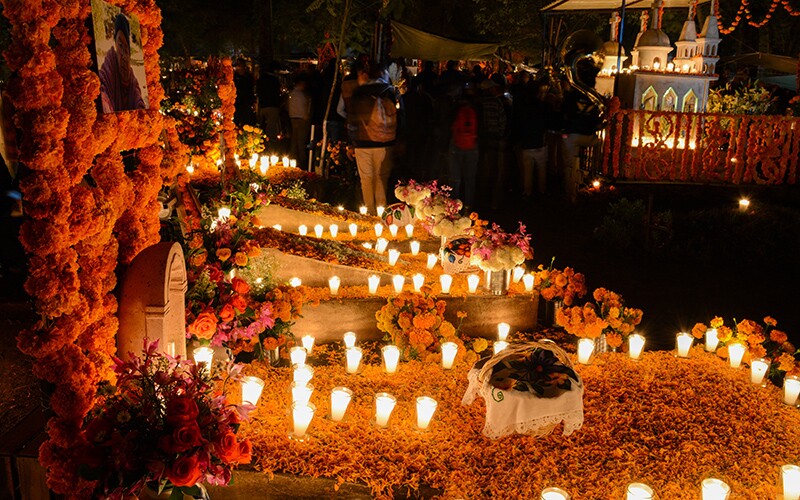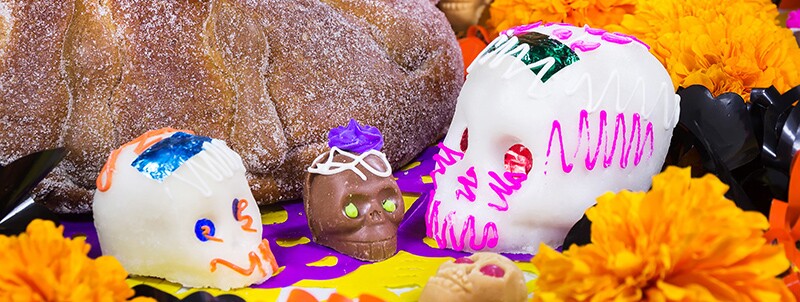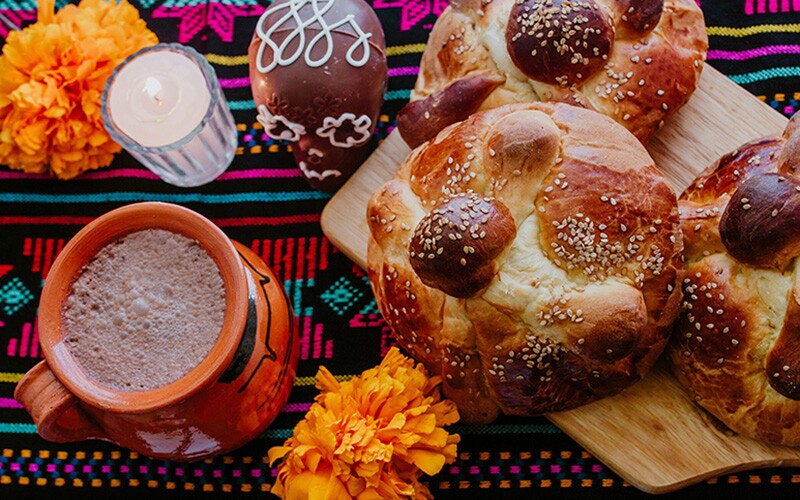During Day of the Dead, or Día de Muertos, October 31 through November 2, families gather together to remember and honor their deceased loved ones. A sacred, joyous time, Day of the Dead traditions include food and flowers, visits with family members, prayers, and stories about those who have died.
Day of the Dead began as a traditional Mesoamerican celebration in southern Mexico meant to guide the spirits of departed loved ones in the afterlife. Today, the holiday is observed throughout the country and includes Christian influences.
Traditions
Customs vary by region, and some Day of the Dead traditions are more well-known than others.

Ofrendas
Central to the celebration are ofrendas, individualized altars designed to remember departed loved ones. They often include photos, possessions of the deceased, candles, flowers, calaveras, water, and toys for los angelitos (little angels). Pan de muerto and small portions of favorite foods and drinks of the deceased are also included.
Marigolds
One Aztec tradition that continues today is decorating with cempasúchil (marigold) flowers. The vibrant colors and scent are thought to guide spirits to visit the living during the celebration. They are also a beautiful representation of the fragility of life.
In addition to vases of living flowers, children often make marigolds out of tissue paper and pipe cleaners to help decorate ofrendas.

Sugar Skulls
Calaveras, another Aztec tradition, are skulls made out of compressed sugar and water with the name of the deceased written on the forehead. A reminder of the cycles of life, calaveras are colorful folk art skulls decorated with colored foil, icing, beads, ribbons, and feathers.

Food and Drink
Families gather to eat pan de muerto along with their loved ones’ favorite foods and drinks and share stories and memories of past family members. Pan de muerto is a special sweet bread baked especially for the holiday, with recipes that vary from region to region.
Moles, tamales, chocolate, candies, and drinks of atole and coffee are other common foods made for the occasion.
Regional Traditions
In some places, such as the Sierra Norte region of Oaxaca, bells ring from midnight on November 1 through November 3, with the sounds of the bells varying in tone. Light, tinkling bells welcome the souls of deceased children (los angelitos), and deeper tones sound for adult spirits. Some people may also build small welcoming fires to guide visiting spirits through open doors and windows.
In other regions, people may leave out blankets and pillows for visiting spirits to rest or include a wash basin, soap, and mirrors.
Some areas feature special dances for the occasion, such as La Danza de los Viejitos in Michoacán.
Remembering the Past
These and other traditions are an important way of keeping families strong as they remember ancestors and their stories.
As your family gathers for Día de Muertos, consider activities that will help you remember your family members. Don’t forget to record your ancestors’ memories on FamilySearch as you share their stories. Think of it as a digital ofrenda!
Discover More about Your Mexican Heritage
At FamilySearch, we care about connecting you with your family, and we provide fun discovery experiences and family history services for free. Why? Because we cherish families and believe that connecting generations can improve our lives now and forever. We are a nonprofit organization sponsored by The Church of Jesus Christ of Latter-day Saints. To learn more about our beliefs, click here.








